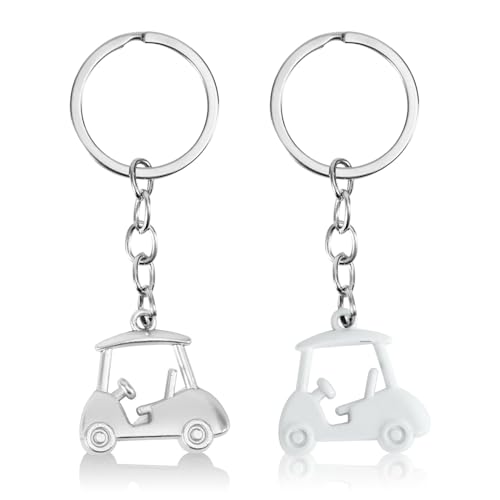Ever wondered why some golf balls seem to soar further down the fairway than others? It’s not just your swing that’s at play. The type of golf ball you’re teeing up can make a significant difference.

You’ve probably heard the debate at the 19th hole: Do harder golf balls really go further? It’s time to dive into the science behind the flight of your golf ball and see what factors contribute to those extra yards.
Understanding the characteristics of golf balls can be the key to improving your game. So, grab your favorite club, and let’s get ready to unravel the mystery behind the distance of your drive.
The Importance of Golf Ball Choice
When you’re out on the greens, chasing that elusive lower score, every single choice you make can have a significant impact—right down to the golf ball you tee up. As someone who has spent a lifetime fine-tuning their swing, you’ll know that the details matter. And in the case of golf balls, it’s not just about preference, it’s about performance.
The core construction of a golf ball can influence its flight, and how it reacts upon landing. Softer golf balls, typically preferred by players with a keen sense for feel, can offer more spin and control, which is pivotal around the greens. However, it’s the harder golf balls that beg the question: do they indeed travel further?
Contrary to popular belief, it isn’t just the hardness but the overall design that governs distance. Modern golf balls are feats of engineering, designed to provide a balance between distance, feel, and durability. While harder balls tend to be more resilient and retain their shape against fast swing speeds, they can also provide a lower spin rate, which might result in extra yards off the tee.
But here’s the kicker: even the best ball won’t do much for your game without the right technique. Your swing speed is a crucial factor; different balls perform best with different swing speeds. If you’ve got a faster swing, a harder ball might complement your style, cutting through the air for those extra yards. On the flip side, if your swing is on the slower side, a softer ball could help you achieve better results by maximizing the energy transfer at impact.
- Softer golf balls: Greater spin and control, typically favored by players with a refined short game.
- Harder golf balls: Potentially longer distance, suited for golfers with faster swing speeds.
Make no mistake, experimenting with different balls is more than just a trial; it’s a journey to understanding your game. When you find the right golf ball, it feels like the last piece of a puzzle falling into place, transforming your golf experience by aligning your equipment with your skills. Just remember, while you’re pursuing that perfect shot, never overlook the importance of the humble golf ball—it might just be the edge you need to shave off those few stubborn strokes.
The Relationship Between Ball Hardness and Distance
When you’re out there meticulously planning your next shot, it’s worth considering that the hardness of your golf ball plays a key role in how far it will travel. Harder golf balls are generally constructed with a firmer core, which does not compress as easily on impact compared to their softer counterparts. This firmness lends itself to a higher energy transfer from club to ball, meaning more distance off the tee.
It’s tempting to think that the harder the ball, the further it’ll go, but it’s not that straightforward. Swing speed is a crucial factor. If you have a high swing speed, you’re likely to benefit more from harder golf balls. They can better withstand the force of your swing and create less spin, which often translates to increased distance.
On the other hand, not everyone has the swing speed of a tour pro. Most amateur golfers have a moderate swing speed and will find that mid-compression balls offer the best balance between distance and control. These balls can still provide the feel you need around the greens while giving you a bump in distance off the tee.
The surface and the material of the golf ball cover also play a part in the overall hardness and performance. Urethane covers found in many tour-level balls offer a softer feel and more spin on approach shots and around the greens, while Surlyn covers, usually associated with distance balls, offer less spin and more durability.
To get the full picture, let’s throw some light on a few important considerations:
- Temperature influences: Colder weather can make any golf ball feel harder, affecting its performance.
- Compression rating: Lower numbers indicate a softer ball, while higher numbers signal a harder ball.
- The importance of fit: Always match the ball to your unique swing characteristics.
Remember, there’s no one-size-fits-all when it comes to golf balls. It’s about finding that sweet spot where ball characteristics complement your swing and playing style. So next time you’re picking out golf balls, think about the journey they’ll take from the tee box and not just the number on the scorecard.
The Science Behind Golf Ball Flight
When you’re out on the course, aiming to shave strokes off your game, understanding the flight of a golf ball might just give you that edge. It begins the moment your club makes contact. Energy transfer is the name of the game here. The more efficiently your swing transfers energy to the ball, the further it’ll soar. That’s the basic science.
But it gets more intricate. There’s this thing called the coefficient of restitution (COR). It’s a fancy way of saying “bounciness”, and it affects how much energy is maintained in the ball post-impact. Harder balls typically have a higher COR, which means they rebound with more vigor, leading to increased flight distance. Yet, remember, what works for one golfer might not work for you. Your swing speed is a unique variable in this equation.
Imagine your golf ball is a spacecraft. Its cover and dimple pattern are its heat shields and thrusters, dictating its aerodynamics. The dimples reduce air resistance and allow the ball to cut through the atmosphere cleanly, much needed for long flights. And just like astronauts training for a mission, you too can optimize your ball’s flight by choosing ones with a dimple pattern that complements your playing style.
Let’s not forget about spin. Backspin creates lift by generating a difference in air pressure on the top and bottom of the ball, much like the aerodynamic lift on an airplane wing. A harder ball may spin less off the driver, which can be good for reducing hooks and slices but may compromise control on the greens where spin is your ally. This delicate balance is essential for top-notch performance.
Mastering these principles doesn’t happen overnight. But with practice, you’ll start to notice how different golf balls react to your individual swing. Here’s a tip: during your next practice session, try out a variety of balls with different hardness levels. See how they respond to your swing speed and style. You’ll soon discover your ideal match for maximum distance.
Factors Affecting Golf Ball Distance
When you’re out on the course, you might wonder what really influences how far your golf ball travels. It’s not just about the hardness. Your performance is also shaped by key elements that, when understood, can help you up your game and shave strokes off your score.

Swing Speed is a major player here. Golfers with higher swing speeds can compress the ball more effectively, which can translate to greater distance—especially with harder balls. However, if your speed isn’t up there with the pros, a low-compression ball might actually serve you better by bouncing off the clubface with greater energy.
Then you have the Launch Angle. Ideally, you want to hit the ball at an angle that maximizes its time in the air but doesn’t send it skyrocketing to where it just drops straight down. Finding this sweet spot is a physics lesson in itself and can depend a lot on how and where you strike the ball with your club.
Another crucial factor? Spin Rate. Backspin keeps the ball in the air longer, potentially helping it fly farther, but too much can cause ballooning, where your ball loses forward momentum. Matching your swing with the right spin rate calls for some trial and error, but you’ll find that sweet spot.
Ball Construction also plays a pivotal role in determining distance. Multi-layer balls can offer a blend of distance and control but may require a faster swing speed to fully benefit from their design. Meanwhile, two-piece construction generally provides more distance for the average golfer due to lower spin and enhanced energy transfer on impact.
Lastly, don’t overlook Weather Conditions and Elevation. Icy cold air can stiffen the ball and reduce bounce, while warmer weather can have the opposite effect. High altitudes can make your ball travel further due to less air resistance.

Remember, knowledge of these elements combined with practice is your best bet for finding that perfect ball and swing that’ll send your shots soaring down the fairway. Keep experimenting, and you’ll get the hang of it.
Choosing the Right Golf Ball for Your Game
When you’re trying to shave strokes off your game, picking the right golf ball is as crucial as selecting the right club. The quest for more distance may make harder balls seem attractive, but there’s much more to consider.
Swing speed plays a pivotal role in your choice. If you have a high swing speed, a harder golf ball can offer the compression necessary to achieve that satisfying long drive. But if you’re sporting a slower swing, a softer golf ball may be better suited for you, aiding you with extra distance thanks to its lower compression ratio which allows for better energy transfer at impact.
Next, think about feel and control. Are you looking to have a more responsive ball around the greens? Softer balls can provide that nice touch, offering more spin and control, making them ideal for shorts shots and putting. On the other hand, if you find yourself often off the fairway and in need of reduced spin to straighten your shots, a harder ball might be the ticket.
—

Consider the conditions you frequently play in. Windy conditions can wreak havoc on your game, and a lower trajectory shot with a harder ball might stay on course better. Yet in wetter conditions, a softer ball can offer more spin and stop faster on the greens.
—
When choosing, don’t overlook the construction of the golf ball. Multi-layer balls offer a compromise between distance and spin control. They have a firmer core, with outer layers designed for a softer feel. This makes them a versatile choice and great for players with mid-range handicaps who want the best of both worlds.
Experimentation is key. Grab a sleeve of different types of golf balls and hit the course. Pay attention to how each one reacts to your swing, your approach, and even your putter. Only through trial and error will you find the perfect match for your game.
Conclusion
You’ve seen that the right golf ball can make a significant difference in your game. Remember, it’s not just about hardness or distance; it’s about what complements your swing speed and playing style. Whether you’re powering through with a high-speed swing or focusing on control with a slower tempo, there’s a ball out there for you. Don’t shy away from a little trial and error. After all, finding your perfect match on the green is a game-changer. So grab a sleeve of different balls and see which one takes your game further. Who knows? The next one you tee up might just be your new secret weapon.










